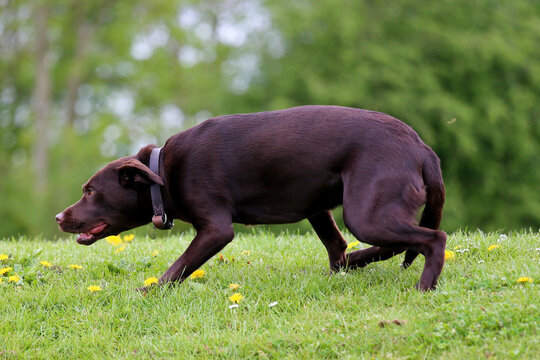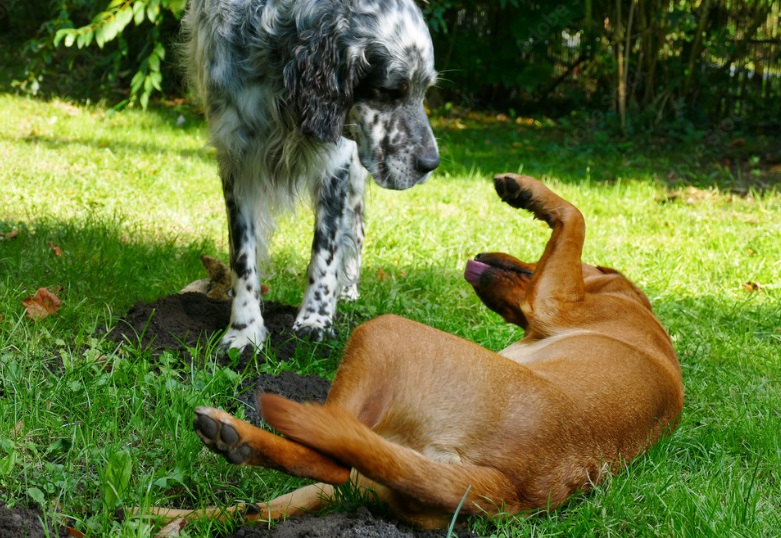Dogs often show submissive behavior. They can show it in a variety of ways, from lowering their head, showing their belly, or putting their tail between their legs. Now, submissive dog behavior is not always a good thing. Sometimes, it might be a sign of a stressed dog. Why do some dogs show submissive behavior? And others show dominant behavior?
Today, we will try to understand the hierarchy of dominant and submissive dogs. And explain when the submissive behavior is a good thing, and when you might need to react.
The Root of the Behavior
Submissiveness is an instinctual behavior, dating back to the ancestors of dogs. It is how pack animals, namely wolves, live in the wildlife. We have to remember that dogs are descendants of wolves.
In the wild, there is always an alpha leader of the pack and the lowest-ranking dog. Everyone in between falls in line. When a dog is showing submissiveness, it is a sign of respect and means he trusts and respects you.
This doesn’t mean your dog will not defend you or be a good watchdog. It means your dog accepts you as the leader of the pack and trusts you will take care of him and offer protection as well.
But we have to mention that some dogs also show submissive behavior when they feel threatened or scared. For example, it can be triggered by other aggressive dogs, lightning storms, or when they are abused.
You can recognize a submissive dog by being calm and not aggressive. There are many other signs, and we will mention them later.
What Are Some Common Submissive Behaviors?
There are different ways dogs show their submissive manner. And there are many different behaviors. Let’s take a look at them.
Submissive Urination
Some people also call it excitement urination, a common behavior in puppies. It can also happen in your adult dog. Submissive urination or excitement urination is different from inappropriate urination.
It happens when a person or animal approaches or stands over the dog. And dogs urinate to show deference to another party, or due to fear or insecurity.
Puppies often grow out of this behavior on their own. You can reduce submissive urination by working on improving your dog’s confidence. Never scold or punish your dog for submissive urination. It can make the problem worse.
Exposing The Abdomen
Dogs show their bellies or roll onto their side or back when approached by another person or animal. This is another submissive sign. We can describe it as an invitation to play or a request for belly rubs and attention.
Be gentle and move slowly, so that you do not intimidate the dog. If you want to rub your dog’s belly, do it slowly and gently.
Averting Gaze
For most dogs, direct eye contact is considered a threat. Even more when it happens between two dogs. So, by averting their eyes and looking away, dogs show they are not trying to challenge the other party. Sometimes dogs may stare at us for other reasons. But it should not be considered an act of dominance.
Ears Flattened Or Hheld Back
When we talk about body language, one of the best signs of submissive behavior is flattened ears or held back. We have to remember that most dogs keep their ears somewhat erect when at ease or relaxed.
But when they hold their ears back or flatten them, it is a message that the dog is worried or fearful. Yet, it is also a sign of submission.
Lowered Tail
If you want to talk about signs of a nervous and scared dog, look no further than its tail. When a dog is lowering its tail, it is a sign of anxiety, fear, and stress. But when a dog is wagging its tail low or slightly tucked, it is also a sign of showing submission.
Licking The Muzzle Of Another Dog
In the canine world, licking the muzzle is a way of communication. Dogs do it to calm another dog down in a tense situation, which is also why many dogs lick their owners to calm them down.
Muzzle licking also happens when two dogs meet for the first time. OR when they have known each other for years. It is normal behavior to show respect.
Understanding The Difference Between A Submissive And A Scared Dog
When it comes to dealing with a submissive dog, one of the biggest mistakes owners make is they confuse it with an upset and depressed dog. As we said before, many signs and behaviors can be attributed to both submissive and scared animals.
Dogs think differently than humans. So, when they want to show respect to their pack leader, they show submissive behavior. They give space to the leader, avoid eye contact, and lower their head. For a dog owner, it might be a sign that the dog is upset. But in the dog world, it means the dog is showing submissive behavior to the pack leader.
Now, there is a fine line between a submissive dog and a scared dog. The best way to determine which one is it is to look at the complete body language of your dog and the big picture.
How To Build Your Dog’s Confidence?
I mentioned previously that some puppies grow out of their unwanted behavior problem like submissive urination. And as an owner, you can help your dog by building his confidence up. That is something owners have to work with every dog. Now, that doesn’t mean you should turn your playful, friendly, submissive dog into a dominant and aggressive dog.
But building your dog’s confidence will result in a much happier dog all around. Here are some ways to build up his confidence.
Work On Obedience Training
Daily obedience work, even for a short time, can give confidence to dogs. The most important part here is to remember to let your dog win. Do not give your dog challenging tasks until it masters the basic commands.
Giving harsh and complex commands to a submissive dog will make matters worse. Use positive reinforcement to reward good behavior with treats and dog food.
Socialize Your Dog
Socialization is another way to build your dog’s confidence. And when I say socialization, I do not mean going to the dog park and letting your dog play with other dogs. Bringing a submissive, anxious dog to the park is a huge mistake. Your scared dog might get even more nervous because it doesn’t feel confident around 10 dogs.
Instead, you should start by introducing your dog to new people, a few at a time, new environments, scents, and of course, dogs. But do it one or two dogs at a time.
Give Your Dog A Job
For example, you can give your dog a job to carry a ball on your walks. That will give your puppy a sense of worth, and accomplishment, and build its confidence.
Most dogs are able to work. But it is your job to find them an activity they enjoy and do it with pride.








